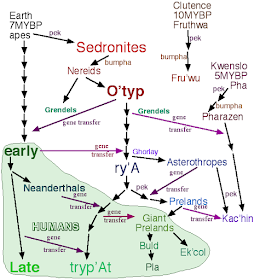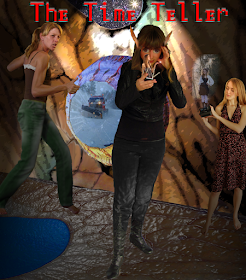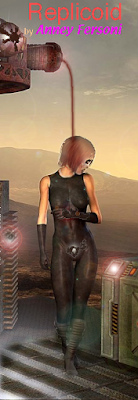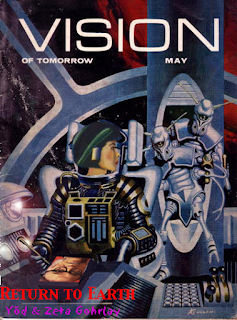It was
two years ago when I first became aware of the existence of the tryp'At. During the past two years, I have struggled to learn about the tryp'At and their special role as the current
Overseers of we Earthlings.
Currently,
Yōd is waiting impatiently for me to write the third chapter of
A Search Beyond. Not long ago, when Yōd set up a website to hold the text of that story, she went ahead and provided a
Table of Contents, complete with chapter titles. She called Chapter 3 "the tryp'At Overseers".
Overseer Sachiz
In the
first chapter of
A Search Beyond, Overseer Sachiz arrives on Earth and promises that the
tryp'At Council will decide if the
replicoid of
Isaac Asimov can remain on Earth.
The Overseers are a kind of police force that watches over Earth. The goal of Overseers is to prevent
Interventionist agents from interfering with the normal course of cultural development on primitive planets like Earth.
 |
| the Sedronite family tree |
I
first heard about the existence of the tryp'At from
Anney Fersoni. I suspect that Anney had contact with
Kach in the
Hierion Domain and as part of Kach's story about the origins of humans as a species, there was mention of the
O'typ.
All in the Family
Among the revelations made by Kach was the suggestion that the
Nereids were constructed millions of years ago as a primate variant. According to Kach, the O'typ were a finely-crafted daughter species of the Nereids that had been carefully taken through a de-evolutionary process aimed at regressing a subpopulation of Nereids towards a biological form that could successfully persist in the Hadronic Domain (our 3 dimensional universe of hadronic matter) for an extended period of time.
Eventually the O'typ evolved into the
ry'A by an artificial process that involved on-going gene transfer between Earth and worlds of the Galactic Core where the ry'A resided. Rumor has it that when
R. Gohrlay was still in her xenophobic phase, the O'typ were forced out of our galaxy and they resided on a planet in the Andromeda galaxy. I've been aware of the ry'A for
almost two years, but I've been unable to learn very much about them. It may be that the ry'A were the result of a collaborative effort between the
bumpha and R. Gohrlay aimed at experimenting with the
telepathic abilities of primates.
In the First Reality
Unfortunately, the
Sedronite family tree (shown above) is limited to sketching the apparent origins of the tryp'At here in the
Final Reality. According to Yōd, back in the
First Reality, before R. Gohrlay was brought into existence, the O'typ were used as genetic source material by the
pek when they created the
Prelands. Of course, those Prelands were not identical to the Prelands of the Final Reality.
Given her training as a genetic scientist,
Ivory Fersoni was well motivated to investigate the genetics of the Sedronites and the many twists and turns involved in the genetic manipulations that led to the creation of the tryp'At. In collaboration with Anney, Ivory developed the theory that there was an "age of the X-philes".
According to Anney, the O'typ had three "genders", HX hermaphrodites, HY males and XX females.
Sources
I've never learned exactly how Anney and
Angela were able to access information about
Deep Time from the
Sedronic Domain. According to Yōd, the mysterious hermaphrodite
Resh^Ki served as a kind of guide who could help Anney and Angela explore the information archives of the Sedronic Domain.
Apparently, the tryp'At are genetically very similar to the majority of Earth humans. However, the tryp'At have a few special gene combinations that allow them to use advanced
nanite technology. Their special genetic pattern and their access to special nanotechnology is what allows members of the tryp'At Council to function as Overseers.
As
depicted in
A Search Beyond, one of the special abilities of the tryp'At Overseers is their freedom to "
teleport" to and from the surface of Earth. However, according to Yōd, this is not "true" teleportation. The tryp'At simply slip through "
hierion tubes" and move to and from the Hierion Domain.
According to
Zeta, the tryp'At Overseers are enforcing the terms of the
Trysta-Grean Pact. Unfortunately, I've never seen a copy of this "pact". I assume that it codifies the special version of the
Rules of Intervention that were crafted for Earth.
Take-Over
I've never been told exactly when the tryp'At Overseers began enforcing the terms of the Trysta-Grean Pact. There might not have been a smooth transition from the previous Overseers. About two years ago I
started hearing rumors about an active struggle to define "human" and make it possible to exclude "non-humans" from Earth.
According to Zeta, there was a period of time when
Many Sails was able to shield people like Anney and members of the
Dead Widower Society from the tryp'At Overseers, allowing them to remain on Earth. Was it about two years ago that
Many Sails abandoned that effort and took Asimov to the Andromeda galaxy? In any case,
by 2015 both Ivory and Angela were gone, each of them having found a way to escape from Earth.
It maybe that one of the last acts of
Orbho Jandra was to facilitate the removal of Ivory from Earth. It is not clear that the current Overseers make use of an Orbho as a chief executive. The tyrp'At Overseers apparently use a supervisory Council. If this is so, then a fundamental shift has taken place, leaving Earth free of pek oversight and placing our fate in the hands of humans.
Zeta has an elaborate hypothesis about a sustained effort that was supposedly made to show me that Ivory and her clone sisters were not really human, even by my preferred rather broad definition. I doubt if I ever saw Ivory's "true physical form", but I'm willing to accept that if left to their natural developmental processes, the
Atlantis Clones would not have had the appearance of a typical Earthling.
Of more interest to me are the special features of Ivory's brain, but unfortunately I've never been given access to data concerning the special features of her cognitive apparatus.
tryp'At Humans
Zeta and Yōd agree that, unlike the Atlantis clones, the tryp'At are fully human. In our discussions during the past several weeks, Yōd has repeatedly criticized depictions of the tryp'At as having alien form. Apparently a subtle pattern of tryp'At genes allows for constructive interactions with special
developmental control nanites and that combination produces a tryp'At individual who can efficiently use the
Bimanoid Interface.
Zeta recently confirmed the validity of my
previous guess that the tryp'At who now serve as Overseers had previously functioned as
Observers. Yōd believes that by the terms of the Trysta-Grean Pact, the pek had to abandon
Observer Base. That left a power vacuum that was filled by the tryp'At. Zeta (now reading this blog post over my shoulder) adds this: the new tryp'At Overseers might only be slowly learning how to play the role of Earth Overseers.
In some sense, there has been a reduction in deployment of advanced alien technologies on Earth since the departure of Orbho Jandra. One of the most disturbing
rumors concerning currently used Overseer technology is that there might be intestinal bacteria on Earth that were designed to block our access to the Bimanoid Interface. Since the arrival of Yōd on Earth, I've been amazed by her eating habits. However, upon direct questioning she has denied trying to control her intestinal bacteria so that she can retain control of the Bimanoid Interface and a link to her replicoid in the Hierion Domain.
 |
| sneaking around Irhit to recover lost memories |
In my case, for a short time I was able to use
nicotine to facilitate access to the Hierion Domain. I've never known how my use of the Bimanoid Interface was disrupted, but I can't rule out the possibility that the problem is in the Hierion Domain and attributable to my replicoid,
Irhit.
Svahr
Since the tryp'At are essentially impossible to distinguish from other Earthlings, there have been many rumors that various Earthlings are tryp'At. For example,
Svahr may have been been tryp'At or half-tryp'At. Another rumor suggests that I am tryp'At.
If they were placed into a role as guardians of Earth, it is natural to
wonder if the tryp'At Overseers are actually puppets of R. Gohrlay or
Grean. In my particular case, if I am tryp'At, then I must ask: am I a kind of "sleeper agent"? And if so, which side am I on?
To some extent, we still live in Grean's Galaxy. The
Kac'hin were crafted as human-like appendages for the
Huaoshy. There is no reason to believe that Grean is done with Earth. The tryp'At Overseers might provide the convenient illusion that humans are now in control of Earth, but the tryp'At might now be doing the bidding of Grean and the Huaoshy.
When I'm not being paranoid about the Huaoshy, I can always fret about the ultimate fate of R. Gohrlay and her secret agent
Trysta Iwedon.
Yōd believes that Svahr is both a
descendant of Trysta and an active member of the
Retrofuturians. To the extent that there is any organized resistance to the tryp'At Overseers, that resistance seems to involve Interventionist agents such as Svahr. Zeta describes the cat and mouse game played by the Overseers and the Retrofuturians as being "continuing negotiations" over how to interpret the Trysta-Grean Pact. Zeta thinks that such "negotiations" are an inevitable and persistent feature of Earth's future.
Tools
The pek Overseers had the ability to monitor every
zeptite endosymbiont on Earth. Zeta believes that the current tryp'At Overseers are much less sophisticated; they seem to carefully
monitor the Internet and they are always watching for evidence of Interventionist activity on Earth.
The tryp'At Overseers
apparently believe that the replicoids of humans are not allowed on Earth. However, there is some evidence that the Retrofuturians are able to easily send replicoids from the Hierion Domain to Earth. If so, it is not clear that the Overseers are equipped to prevent visits by replicoids to Earth; they can only hope to act so as to limit the duration of such illegal visits.
Zeta, Yōd and I are currently investigating how the
Phari helped with the genetic tinkering that led to the creation of the tryp'At. That investigation requires an understanding of events in Deep Time, particularly the
Asimov Reality.
Currently, I'm investigating the on-going interactions between the Retrofuturians and the tryp'At Overseers. While some might call these interactions "negotiations", as far as I can tell it is more appropriate to use terms like "guerilla warfare" and "reprisals".
Next:
speculation about Observer Base





















































